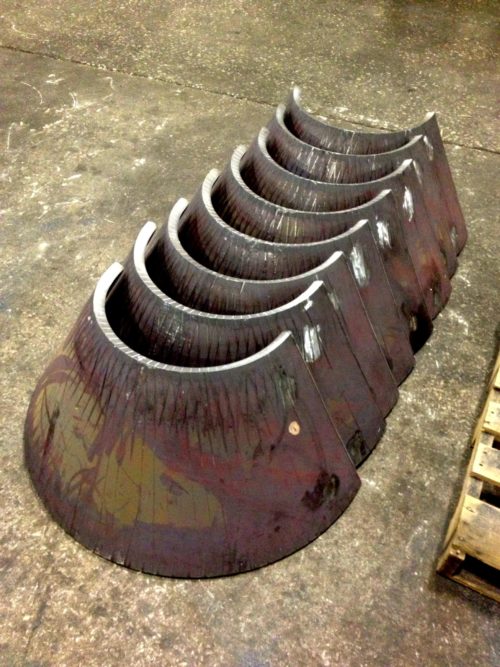Metal fabrication refers to the process of cutting, shaping, or molding raw or semi-raw metal materials into an end product. Depending upon the type and grade of metal, as well as the desired end product, metal fabricators may employ a variety of techniques to manufacture cost-effective, high-quality components for a wide range of industrial applications.
Types of Metal Fabrication Processes
Some of the different metalworking methods metal fabricators employ include:
Cutting
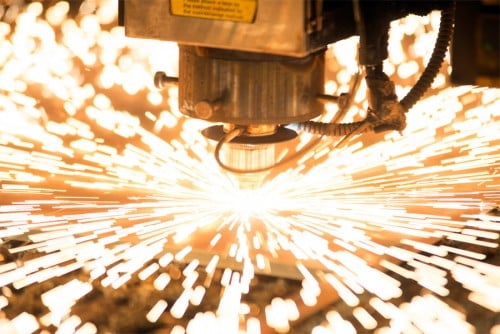
- Sawing is the oldest method of producing straight cuts through metal materials.
- Laser cutting employs a high-powered, focused laser beam of light to cut through the metal materials.
- Waterjet cutting operations utilize a high-powered water stream to cut through different materials, including metal.
- Plasma Cutting uses a mixture of swirling gases to cut through metal.
- Shearing uses two large blades to cut through metal like a giant pair of scissors.
- CNC cutting uses a computer-controlled machine to make precise cuts through metal via a variety of metal cutting techniques (e.g., laser cutting, plasma cutting, etc.)
- Die cutting employs steel rule (flatbed die cutting) or cylindrical (rotary die cutting) dies to cut out precise metal shapes.
Forming/Bending
Unlike cutting, forming (or bending) doesn’t remove material from the metal work-piece. Instead, the process alters the work-piece with a machine such as a press brake, or by a hand-held method such as with a hammer, or die to fit the required specifications.
Welding
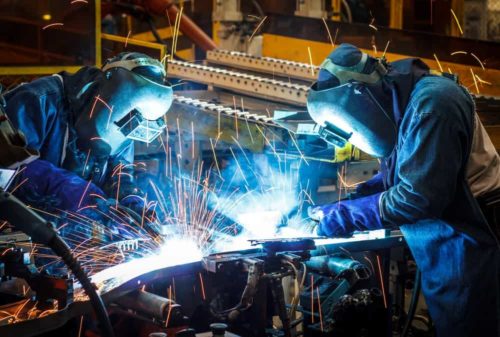
- Submerged arc welding (SAW): This welding method employs a continuous electrode to create an arc between the welding rod and the work-piece. The addition of a thick granular flux forms a shield that protects the weld zone from atmospheric contamination during operations.
- Shielded metal arc welding (SMAW): This welding method—also referred to as stick welding—uses a welding rod coated in flux that carriers a high-power electrical current. The coating breaks down during welding operations, forming a layer of slag and a gas shield that protects the weld as it cools.
- Gas metal arc welding (GMAW): This welding method—also known as MIG welding—relies on an adjustable and continuous solid wire electrode. During operations, the electric arc formed between the work-piece and the electrode heats and melts the base metals to form the weld.
- Gas tungsten arc welding (GTAW): This welding method—also called TIG welding—requires the use of a non-consumable tungsten electrode. It produces strong welds without fillers.
- Fluxed core arc welding (FCAW): This welding method is similar to GMAW welding, except it utilizes a tubular wire electrode filled with flux rather than a solid wire electrode. Self-shielded FCAW operations rely only on flux to protect the weld zone, while dual-shielded FCAW operations rely on both flux and an external shielding gas.
Stamping
Uses a top and bottom die molded into a custom 3-dimensional shape. When the metal is pressed between the two dies, it conforms to the desired shape. This process is used to make many complex metal shapes, such as body panels for the automotive industry.
Machining
Uses CNC-controlled machinery with various cutting tools to rapidly produce a custom 3-dimensional metal component by removing unwanted materials.
Advantages and Applications of Metal Fabrication Processes
There are several different types of metal fabrication processes employed by industry professionals to produce metal parts and products. As each process utilizes different techniques and equipment, it offers distinct advantages and best use cases.
Advantages and Applications of Cutting
Perhaps the most ubiquitous of all metal fabrication processes, cutting can be employed alongside other methods. In general, cutting offers several advantages with more modern techniques providing enhanced manufacturing capabilities. Some of the advantages of using cutting to fabricate metal parts include:
- Greater precision
- Higher repeatability
- Faster production speeds
- Better cost-effectiveness
Advantages and Applications of Forming/Bending
Metal fabricators use forming operations—e.g., rolling, indenting, and bending—to produce many metal parts, such as pipes, enclosures, and boxes. The advantages of using these operations include:
- Broader product capabilities
- Greater part design flexibility, including for complex shapes and geometries
Advantages and Applications of Welding
In general, welding allows for minimal waste production, reduced labor and material costs, and process portability. Each of the individual welding techniques also offers unique benefits. For example:
TIG Welding Benefits
Commonly used for aluminum and aluminum alloys, TIG welding produces a better surface finish than MIG welding and doesn’t require a filler material to produce the weld.
MIG Welding Benefits
Commonly used on steel, MIG welding does require the use of consumable filler material (i.e., the feeding wire). However, compared to TIG welding, it is faster and easier to control.
Sticking Welding Benefits
Commonly used on iron and steel, stick welding is the simplest welding technique. As such, it is used extensively for industrial fabrication applications.
Advantages and Applications of Stamping
Stamped parts are found across a diverse set of industries. The stamping process allows for:
- Higher precision and accuracy
- Faster production speeds
- Lower per-unit production costs (for high-volume runs)
Advantages and Applications of Machining
Machining is a broad industrial term for subtractive manufacturing processes, such as drilling, milling, and turning. While some companies still rely on manual machining units, many companies have adopted the use of computer numerical control (CNC) machining equipment. The latter enables industry professionals to achieve the following:
- Tighter tolerances
- Higher production consistency
- Greater cost-efficiency (for small to medium runs)
Metal Fabrication Solutions From G.E. Mathis Company
At G.E. Mathis Company, we offer industry-leading metal fabrication services to customers across a diverse set of industries. Equipped with a 135,000 square foot, state-of-the-art manufacturing facility and over a century of industry experience, our team provides:
Precision Laser Processing
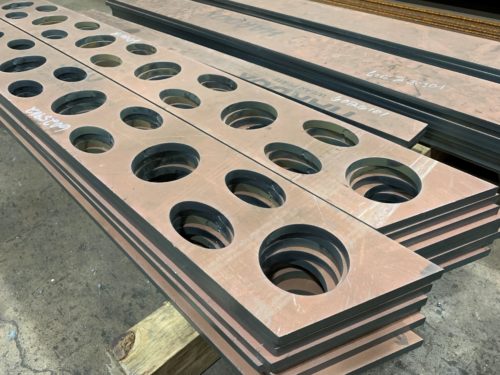
Precision CNC Plasma Cutting
We utilize 4-axis machines capable of high-definition cutting action to provide precision CNC plasma cutting services. The equipment’s 400 amp, straight, dual-head, and contour beveling capabilities help us provide superior results across a wide variety of materials, including carbon, aluminum, stainless steel, and exotic metals.
Precision Forming/Bending
For our precision forming/bending operations, our team utilizes eight hydraulic press brakes, including two equipped with CNC capabilities. These machines feature 400- to 1,000-ton capacities and accommodate thicknesses up to 2 inches and lengths of 20, 20, 30, 23, 25, 40, and 48 feet.
Some of the formed/bent components we fabricate include:
- Cones
- Cylinders
- Ob-rounds
- Segments
- Channels and angles
- Bump formed sections
We process a variety of materials in these operations, such as:
- Carbon steel
- Stainless steel
- Aluminum
- Brass
- Bronze
- Copper
- Titanium
- Hardox® wear plate
Precision Welding
Our AWS-certified welders are capable of providing precision arc and MIG welding services using CNC-controlled welding and fully automated processes, including:
- Dual-wire submerged arc welding
- Flux cored arc welding—i.e., FCAW
- Gas metal arc welding—i.e., GMAW
- Gas tungsten arc welding—i.e., GTAW
- Shielded metal arc welding—i.e., SMAW
- Submerged arc welding—i.e., SAW
We weld materials up to 12 feet wide and 50 feet long, including:
- Carbon steel
- Stainless steel
- Aluminum
- Hardox® wear plate
HARDOX® Wearparts Fabrication
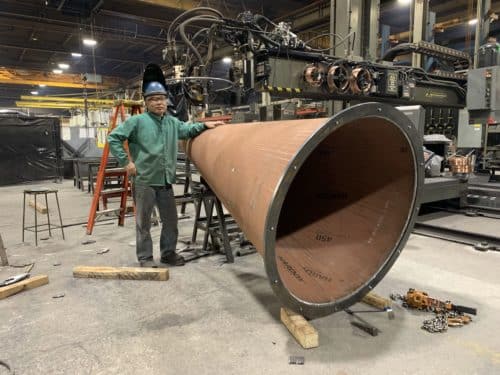
- HARDOX 450
- HARDOX 500
- STRENX 100 (Domex® 100)
- STRENX 110 (Domex® 110)
- STRENX 700
- WELDOX 100
- WELDOX 110
These products are available in up to 2-inch thicknesses with industry-leading tolerances to meet even the most demanding application requirements.
In addition to being an ISO 9001:2015-certified manufacturer, G.E. Mathis Company can provide the following services:
- PPAP (Production Part Approval Process) – All Levels
- FAIR (First Article Inspection Report)
- Capability Studies (Statistical Process Control)
- CMRT (Conflict Minerals Reporting Template)
At G.E. Mathis Company, we have over a century of experience providing metal fabrication solutions. If you have a metal fabrication project, we can meet your needs. Contact us today for more information about our metal fabrication capabilities or request a quote from one of our experts for your next project.






